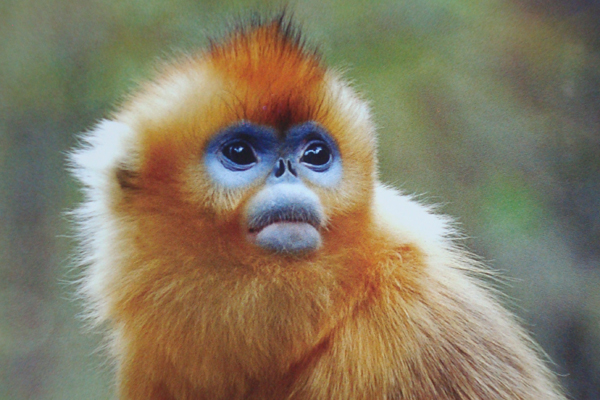GOLDEN SNUB-NOSED MONKEY
Pygathrix (or Rhinopithecus) roxellana
Physical Description
The Golden, or Sichuan, Snub-nosed Monkey is indigenous to Tibet. Like the Giant Panda, very few of these animals exist in the wild. The Golden Snub-nosed Monkey has a small upturned snub nose with exposed nostrils, and lappets at the sides of its mouth. The Monkey’s name derives from its nose and its beautiful reddish-golden hair. The Golden Snub-nosed Monkey’s face, throat, legs, and underparts are reddishgold.
A portion of the Monkey’s tail and neck are light grey. The remainder of the Golden Snub-nosed Monkey’s neck and tail are golden brown. The Monkey’s muzzle is white, and the skin around its eyes is blue.
The body length of a male Golden Snub-nosed monkey ranges from 57 to 76 centimetres (19 to 25 inches). The Monkey’s tail length ranges from 51 to 72 centimetres (17 to 24 inches). Males generally weigh between 15 to 39 kilograms (33 to 86 pounds), while females weigh between 6.5 and 10 kilograms (14 to 22 pounds).
Habitat
The Golden Snub-nosed Monkey occupies mixed bamboo, conifer, and deciduous forests from 1,500 to 3,400 metres (5,000 to 11,000 ft) in elevation. The Monkey may descend to lower elevations in the winter.
The Golden Snub-nosed Monkey is most often found in the same places as the Giant Panda. However, the Monkey is better adapted to colder climates and higher altitudes than the Panda, and as a result, the Golden Snub-nosed Monkey’s habitat extends far beyond that of the Giant Panda. The Monkey’s population is mainly found on the southeastern edge of the Tibetan Plateau, in China’s Sichuan, Yunnan, Gansu, Shaanxi, and Hubei provinces, and in Kham, in the Gyalmo Tsawa Rong region, Chugar, and in the dense forest of the Ngawa Dzong (District).
Eating Habits
The Golden Snub-nosed Monkey is an omnivore. The Monkey’s diet varies according to the season. During warm months, the Golden Snubnosed Monkey feeds primarily on leaves from broad-leaf trees and fir and pine needles. Buds, bark, and fruit seeds provide supplementary nutrition. During the winter, however, the Monkey switches to a more limited diet of bark and lichen. The Golden Snub-nosed Monkey also occasionally descends to the ground to feed on grasses and wild onions.
Behaviour and Reproduction
The Golden Snub-nosed Monkey is diurnal (active during the day). Most of the Monkey’s day-to-day activities take place in the trees, but some feeding and social interaction, including play, take place on the ground. The Golden Snub-nosed Monkey is highly vocal. The vocalizations of males are distinctly different from those of females.
The Golden Snub-nosed Monkey lives in family units consisting of one mature male and numerous females. The male leads and protects the unit, often carrying youngsters. Family units gather to form groups of about 60 to 70 monkeys. In the spring, groups of the Gold Snub-nosed Monkey may unite into bands numbering as many as 600 individuals. These large bands disunite and original groups are reformed when cold weather sets in.
Male Golden Snub-nosed monkeys reach sexual maturity at seven years of age. Females reach sexual maturity at four to five years of age. The timing of the mating season varies across the Monkey’s habitat range. In general, the Golden Snub-nosed Monkey mates between October and December, and gives birth between April and June. The Monkey’s gestation period is about seven months. Each mother gives birth to one, or, less commonly, to two offspring, per breeding season. The life span of Golden Snub-nosed monkeys is unknown. The Golden Snub-nosed Monkey is a very alert animal; if frightened, it will quickly flee through the upper levels of the forest canopy.
Present Status
The Golden Snub-nosed Monkey is categorized as Vulnerable in the 2003 IUCN Red List of Threatened Species and is listed under Appendix I of CITES. The Monkey is under first class protection in China. In 1991, the Golden Snub-nosed Monkey population was estimated to number between 10,000 and 15,000. The Monkey is rarely spotted moving in groups of over 100 anymore.
Threats to Survival
The Golden Snub-nosed Monkey is intensively hunted for its valuable pelt and for other body parts that are used in traditional medicine. The Golden Snub-nosed Monkey is also hunted for food. In some cases, entire communities have carried out mass round-ups of the Monkey.
Furthermore, the Golden Snub-nosed Monkey is a valuable zoo exhibit, and as such there have been reports of poaching of live monkeys for sale to zoos. Other threats to the species’ survival include habitat loss due to deforestation and environmental degradation.
References
BBC, Science & Nature – Wildfacts – Sichuan golden snub-nosed monkey, http://www.bbc.co.uk/nature/wildfacts/factfiles/346.shtml, Aug 2004.
Emanoil, Mary, ed.,1994: Encyclopedia of Endangered Species, Gale Environmental Library, Detroit, Michigan, xvii.
Eudey, A. & Members of the Primate Specialist Group, 2000: Rhinopithecus roxellana. In: IUCN, 2003: 2003 IUCN Red List of Threatened
Species, http://www.redlist.org, Aug 2004.
Kirkpatrick, R.C., 1995: “The Natural History and Conservation of the snub-nosed monkeys (Genus Rhinopithecus).”
Munoz, P., 1999: Pygathrix roxellana, Animal Diversity Web, http://animaldiversity.ummz.umich.edu/site/accounts/information/
Pygathrix_roxellana.html, Aug 2004.
Schaller, R., 1985: “China’s Golden Treasure,” International Wildlife.
World Conservation Monitoring Centre, WCMC/WWF Species Under Threat – Golden Snub-nosed Monkey, http://www.wcmc.org.uk/species/
data/species_sheets/goldensn.htm, Aug 2004.
By: Environment and Development Desk, DIIR, CTA.



comment 0